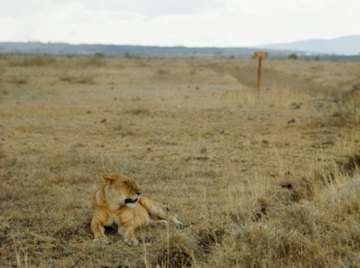
When studying environmental science, students learn about grasslands. Because there are a variety of types of grasslands, students have several choices when selecting a focus for a 3D school project on grasslands. Models can be made to show animals as well as habitat and vegetation found in grasslands from North America to Africa.
Types of Grasslands
About one quarter of the land on Earth is grassland, located on either side of desert belts that circle the earth. Tropical grasslands are found closest to the equator and are hot year-round, whereas those cold winters are typical for North America's tallgrass prairie (located east of the Great Plains of the midwestern United States), the mixed grass prairie (southern Midwest) and the shortgrass prairie (stretching along the Rocky Mountains into Canada). A 3D model showing these belts and the locations of these grasslands can be built from clay or as a diorama. As part of the project, describe how these grasslands differ, such as variations in grass heights, soil types and animal habitats.
Grass Growth
In the African savanna, dead or dry plants are common during dry seasons but grass continues to grow. A 3D grassland project could examine how grass survives. Fill a plastic cup with soil and plant a small clump of grass in the soil. Trim the stems until they are even (about 1 inch above the soil). Color the grass stems with a marker or a pen, and place the cup in direct sunlight. Measure the grass from the tips of the blades to the soil level every day for at least a week. Make note of any new growth above or below the colored ends. This project demonstrates that grass grows despite fires or animals nibbling on it because the grass does not grow from the tips as other plants do. Grass blades grow above each node along the stem. When the tops of the blades are eaten or burned, the grass continues to grow.
Grassland Animals
While studying grasslands, students learn not only habitat, but the animals within that habitat. A 3D project on grasslands can explore the animals that live there. For example, a variety of fast-moving animals can be found in the African grasslands. Research the speeds that each of these animals travel, and create a model that compares these speeds. A model of the African savanna might include a cheetah, a lion, and a zebra. Position the animals as though in a race, with the fastest animal out in front and the slowest lagging behind. Determine why speed might be important for survival in a grassland habitat. For example, animals must be fast to escape predators because of the scarcity of trees in which to hide.
Grassland Biome
A biome is a scientific model for a region where animals and plants exist in a particular climate. Create a model of a grassland biome using a shoebox. Your biome should show weather, terrain, and animal life that exist in the grasslands. For example, in the temperate grasslands of the midwestern United States, you would see such animals as coyotes, bears, deer, hawks, owls and snakes. You would also have a wide mix of grasses, warm to hot summers and cold winters. The terrain should show mountains, rivers, lakes, rocks and other natural formations.
References
About the Author
Renee Miller began writing professionally in 2008, contributing to websites and the "Community Press" newspaper. She is co-founder of On Fiction Writing, a website for writers. Miller holds a diploma in social services from Clarke College in Belleville, Ontario.
Photo Credits
Jupiterimages/liquidlibrary/Getty Images
